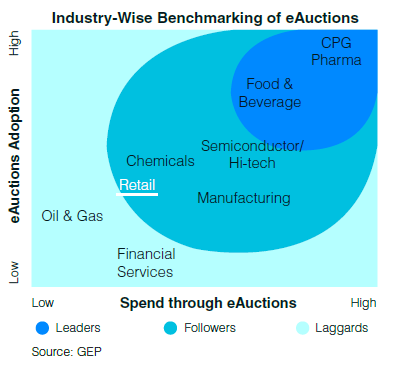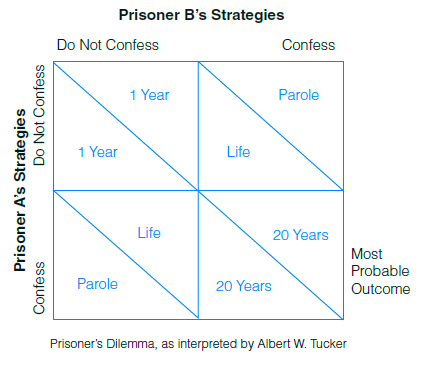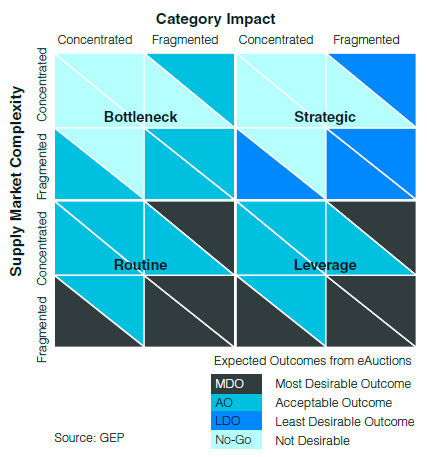Retail has had a tough time of it. With major shifts in consumer behavior, the need for omnichannel investments and increasing pressure on margins, there’s never been a more pressing need to manage costs.
Wondering how to do it?
Our new white paper, Reverse eAuctions: How Retailers Can Optimize Spend and Improve Profitability, looks at how this sourcing strategy empowered by technology can be a great tool, driving competitive behavior to achieve the most favorable outcome for your enterprise. The paper discusses how reverse auctions work at a psychological level, how new technologies have enhanced their capabilities, and how they help bring more spend under control.
What’s Inside:
- Sourcing is a game; learn how to play it
- The advantages of leveraging reverse eAuctions
- How new technologies are making eAuctions platforms a formidable tool
This paper is a must-read for sourcing and retail professionals looking for impactful cost-reduction measures.

RETAIL IN THE POST-PANDEMIC WORLD
Slim operating margins, relentless competition from e-commerce, changing consumer habits — the retail industry has been facing these challenges, all of which have been exacerbated by the pandemic. As a result, many physical retail outlets have been impacted and are closing.
The industry urgently needs to improve its cost and profit margins, and one proven way to do this is through reverse eAuctions. The CPG and pharma sectors, too, face challenges similar to retail and have leveraged reverse eAuctions effectively to drive cost reduction. Reverse eAuction programs, in which suppliers compete against each other online by submitting competitive bids, have the potential to drive incremental savings in the retail space as well, though retailers have been slow in adopting the tool, largely due to misconceptions owing to the lack of understanding about eAuctions and their effectiveness.
THE THREE BIG CHALLENGES FOR RETAIL
CHANGING CONSUMER BEHAVIOR
The retail industry has seen two sharp shifts in consumer behavior: online buying and cost-consciousness.
While the e-commerce sector has gained traction over the past decade, the COVID-19 pandemic has drastically sped up the adoption of online shopping, with people preferring safe, contactless transactions. Given the current social distancing rules at physical retail stores, and ultimately the convenience of online shopping, more and more consumers will likely transition to and continue with online shopping for both essential and non-essential items. The pandemic has also impacted finances, and consumers are now more inclined toward e-commerce, which gives them a wide variety of costeffective options.
Online shopping is here to stay, and retail must adapt.
MANAGING SPEND CATEGORIES
Managing spend has been a challenge for most retailers and their procurement teams. As in most sectors, in retail Goods For Resale (GFR) accounts for approximately 80% of the purchasing budget with 20% of the total supplier base, while Goods Not For Resale (GNFR) contributes to ~20% of the overall spend and has 80% of one’s total suppliers. GFR and GNFR are synonymous with direct and indirect catgories. Managing GNFR has not been a focus for retailers owing to the complex and diverse nature of the spend categories and the large number of stakeholders (influencers) involved other than procurement. GFR, on the other hand, seems relatively simpler to manage due to the highly standardized nature of its categories. However, often GFR and GNFR are managed at a local level, for individual business units and stakeholders have well-established relationships and engagements with local preferred suppliers, making it tough to consolidate demand and adopt a centralized (regional/global) procurement strategy.
INCREASING MARGIN PRESSURE
Poor spend management, rising costs (property, labor, commodity), the need to invest in digital technologies for better customer experiences, strong competition from online retailers and change in consumer behavior have all put great pressure on retailers’ margins.
LEVERAGING REVERSE eAUCTIONS
Retail procurement organizations need to explore alternative ways to reduce costs and drive value, and one way to do that is by leveraging reverse eAuctions. These auctions, however, are not a substitute for traditional negotiation; they are an innovation that can be used additionally.
Although not a new strategy, eAuctions have been modernized in recent years by virtue of technological advancements, making the tool more intuitive and enabling various strategies (like reverse, Japanese and Dutch auctions, for example) for the most desirable outcome. Retailers can drive savings by implementing the right kind of sourcing strategies across both GFR and GNFR, to improve profit margins and drive efficiencies. Reverse eAuctions have been shown to consistently deliver the best price for the desired level of quality and service with greater efficiency and effectiveness.
eAuctions is an often underutilized strategy. Our experience shows it can be a powerful method to increase margin in partnership with merchants and suppliers
— Patrick Hoffmann, Senior Director, GEP
BENEFITS OF eAUCTIONS IN GFR AND GNFR
- Acceleration and Efficiency: eAuctions create time efficiencies for buyers by automating the negotiation process and allowing more bids in less time: 20-40% faster negotiations based on GEP’s experience
- Unbiased and Immediate Feedback: eAuctions provide real-time visibility and feedback, enabling suppliers to stretch and maximize bids based on real market information. Limited manual intervention is structurally unbiased and improves credibility of the feedback
- Targeted Impact: Focus on categories where net cost/margin is the primary consideration
- Targeted Toward Merchant Strategy: Designed in alignment with the retail merchant strategy to achieve the Most Desirable Outcome (MDO)
- Improved Margins: Around 15%-25% cost benefits through enhanced competitive behavior, as estimated by GEP experts
UNLOCK THE TRUE VALUE OF eAUCTIONS: APPLY GAME THEORY
Our research has shown that eAuctions improve efficiencies for merchandising organizations and deliver incremental gross margin improvements. So, how does it work?

The true value of online reverse auctions is in driving competitive behavior to realize the most desirable outcome. An eSourcing event is essentially like a game, and we can apply the rules of the game theory to eSourcing events. The prisoner’s dilemma (illustrated in the figure), one of the most well-known concepts in game theory, demonstrates how reverse auctions work. It describes a situation where two players acting strategically will lead to a suboptimal choice for both. Here, two prisoners suspected of committing a crime together are interrogated separately: they can choose to remain silent or confess. The outcome is dependent upon the unknown action of the other prisoner. Since neither prisoner knows the action of the other, self-interest leads each player to confess and they both end up in prison. This is the most probable outcome, though both players would have achieved their MDO with a different strategy
A similar payoff matrix results in such sourcing events.
Category profile and market environment are the key determinants for gaining an in-depth understanding of supplier tactics and potential outcomes in reverse auctions. Learning from past events and understanding the objective will help change the dynamics of the event and develop the strategy for better outcomes each time.
KEEP IN MIND: MAKE IT UNPREDICTABLE

- Supplier tactics change within the category profile and, accordingly, so do the outcomes of reverse auction
- To ensure potential outcomes are achieved, it is important to change the games at every instance and make the strategy unpredictable for suppliers
- Importantly, while changing the game technique, focus on specific negotiation factors in each instance and not all the factors in one instance
- The rules and structure of reverse auction should be made dynamic in every instance to make it more unpredictable
THE FUTURE OF eAUCTIONS
Moving rapidly toward a digital future, procurement should leverage big data, artificial intelligence, Internet of Things, advanced automation and blockchain to further enhance eAuctions capabilities:
- Robotic Process Automation (RPA): This can be a great tool for repeat auctions and will play a key role in the next generation of eAuctions, with applications ranging from automated RFPs to entirely automated auctions. To give an example, the procurement team at Maersk, a leading integrated shipping company, is developing RPA to execute eAuctions from end to end with no intervention required from the buyer, and Machine Learning (ML) tools that automate contract reading and interpretation for over 15,000 suppliers.
- Chatbots: Successfully employed in customer service and in retail to assist shoppers on e-commerce platforms, chatbots can also assist in eAuctions by providing suppliers with quick access to resources and sharing updates during the event, such as the supplier’s current ranking, the lowest bid, time left in the event, etc. This automated support will give buyers the flexibility to conduct eAuctions for multiple line items at the same time without having to manage multiple suppliers bidding on various line items.
- Market Intelligence: This can be part of the eAuctions software so buyers can look up market information while the event is underway. Having access to real-time information of event proceedings as well as access to market data and sentiment will help buyers gauge how suppliers are strategizing their bids during the online auction. Market intelligence can be accessed easily through market feeds and chatbots that can direct buyers to the specific information they want.
- Expansion of eAuctions to Sales: This is a use case that would work well for the retail industry. eAuctions are a good option not only for commoditized physical goods but also for services and intangibles if the items are welldefined (such that there are no distinctions between the items offered by different bidders). So, along with selling goods, bidders could also be allowed to purchase shelf-space for their items. For example, a common practice in Capex and IT categories is bidders purchasing scrap materials from buyers that they can recycle. Within a single event, the bidders could become both sellers and buyers.
Procurement may once have been considered a cost center, but technology and innovation in sourcing will allow it to function like a profit center, through improved visibility, lower costs, enhanced compliance and better risk management.

ADOPTING A THREE-PRONGED APPROACH
Retailers should look at a comprehensive solution to reduce their GFR and GNFR costs and improve margins. A three-pronged approach will help achieve these goals:
CENTRALIZED STRATEGY TO MANAGE SPEND
Retailers must look to adopt a centralized (regional/global) procurement strategy to manage their GFR and GNFR spend. A decentralized approach increases rogue spending and reduces the opportunity for cost reduction. To manage these categories effectively, it’s important to develop the right sourcing strategy, which requires category expertise, strong sourcing acumen, and skills in negotiation, stakeholder management, change management and supplier management. Procurement can play a vital role in bringing these skill sets to the table.
USE ADVANCED PROCUREMENT SOFTWARE
Retailers should adopt eSourcing tools for RFx and eAuctions to reduce their cost on GFR and GNFR categories and improve margins.
PARTNER WITH SOURCING EXPERTS
Retailers often take a traditional approach to managing their spend, hesitating to outsource these categories. However, partnering with sourcing and procurement companies can bring significant advantages, giving retailers access to expert perspectives and advice so as to achieve value beyond just sourcing.
A combination of these procurement strategies, software and expertise will help retailers implement sustainable costreduction measures, improve cash flow and and get on the path to recovery and growth.

